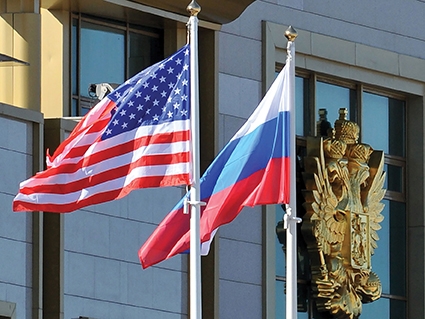US New Containment Policy Against Russia: Now in the Former Soviet Space
Op-Ed
The confrontation between Russia and the US across the former Soviet space and wider Middle East reached new heights over the past few weeks. Several developments indicate the US is changing its military policy in the region and is increasingly worried about Russia’s close relations with Iran and Turkey.
As relations between Russia and the US hit their lowest since the end of the Cold War, the recent meeting between Sergey Lavrov and Rex Tillerson, the Russian and US foreign ministers, serves as a good reflection of the widening gap between the two powers. The ministers discussed Syria, Ukraine and the North Korea, but largely failed to reach any tangible breakthroughs.
Currently, differences between Moscow and Washington in the Middle East are becoming quite fundamental. The proclamation of Jerusalem as Israel’s capital by the US could be one such indication, but Washington is more concerned that Russia has now reached high levels of cooperation with Turkey and Iran that could limit the projection of US power into the Middle East. Looking at a map of the Eurasian continent, one can see Russia in the northern part of the landmass and two bridges which connect it to the Middle East: Turkey and Iran. Having these two countries as close partners increases Russia’s influence in the post-war Syria and elsewhere.
Indeed, it has been one of directions of post-Soviet Russian diplomacy. An entire diplomatic field was created in the 1990s, where Iran and Turkey would be pivotal to Moscow’s ambitions in restraining western (primarily US) influence, be it in the South Caucasus, Central Asia or wider Middle East. Of course, Turkey, Russia and Iran have their own differing interests in the Middle East, but all are under a certain amount of pressure from the US. This could be a rallying point for the three actors. As a reflection of this trend, the Russian, Turkish and Iranian presidents met in Sochi on November 22 last year to reaffirm their attitudes toward the Syrian problem.
Differences between Russia and the US are now also increasing over purely military affairs. In December, the United States said it was considering military and economic measures against Moscow in response to alleged violations of the iconic Intermediate-Range Nuclear Forces Treaty (INF). The treaty, signed between the United States and the Soviet Union in 1987, eliminated for the first time an entire class of cruise and ballistic missiles in Europe. The death of the INF would signal yet another step towards the ever-widening gap between the two countries.
The differences come as the US made the Russian RT television channel (Russia Today) register as an agent, while similar legislature was passed by the Russian State Duma to target foreign media operating in Russia.
The US has also increased its pressure on yet another theater which Russia considers its “own backyard”: Ukraine and Georgia. On November 13, 2017, US special envoy Kurt Volker met the Kremlin aide Vladislav Surkov in Belgrade, Serbia, to discuss the possibility of stationing peacekeeping forces in east Ukraine.
After the talks, the US and Russian envoys indicated that the differences were so extensive that of 29 paragraphs "only three were acceptable” to Russia.
This is important as it again stresses those irreconcilable differences between the US and Russia that have existed over Ukraine for a long time. Washington insisted on Moscow giving up its control of the eastern Ukraine-Russia border, while Moscow argued to the contrary. From a purely geopolitical standpoint, Russia’s acceptance of the US offer would mean losing control over the processes in east Ukraine, meaning the Russians would be unable to send military hardware into east Ukraine when necessary.
On November 18, ABC News reported, quoting a State Department source, that senior aides will present US President Donald Trump with a $47 million plan to finance and sell high-tech defensive weapons to Ukraine to bolster its efforts to repel Russian aggression in east Ukraine.
Some could take this with a pinch of salt, of course, as the US government have been saying so since Trump became president. However, this time round there are additional arguments indicating that the US is considering slowly changing its military policy across the former Soviet space. In a related development, it was announced that the US will be increasing its military support to Georgia. From spring 2018, US Army officers will train Georgian soldiers on defensive tactics. This is what Georgia has lacked for decades, and something that was well reflected in the 2008 Russo-Georgian war.
More importantly, on November 20, the US State Department approved the sale of Javelin anti-tank missiles to Georgia. Tbilisi plans to buy from the Pentagon 410 of the missiles and 72 launch units. The total amount of the proposed deal is $75 million.
The provision of these kinds of weapons will be a landmark development as it will go against the standard US approach to conflicts across the former Soviet Union: ‘no supplies of lethal weapons to Ukraine, Georgia or Moldova, so as not to cause further escalation with Russia.’
Sure, the plan in the White House might not materialize, but it nevertheless reflects a slowly changing thinking in the American political establishment. At the same time, the proposed sales would not drastically change the military balance of power in the region against Russia. But it is still a development important enough to cause concerns in Moscow.
It could be argued that these military developments around Ukraine and Georgia fit into what NATO/US are doing in east Europe; namely, increasing their military capabilities.
To sum up, there has been a substantial ratcheting up of tensions in US-Russia relations over recent weeks. The US is increasing its pressure on Russia through various means available, among them through increased support for Ukraine and Georgia, as a centerpiece of the US strategy of containment of Russia in the former Soviet space.
Emil Avdaliani












